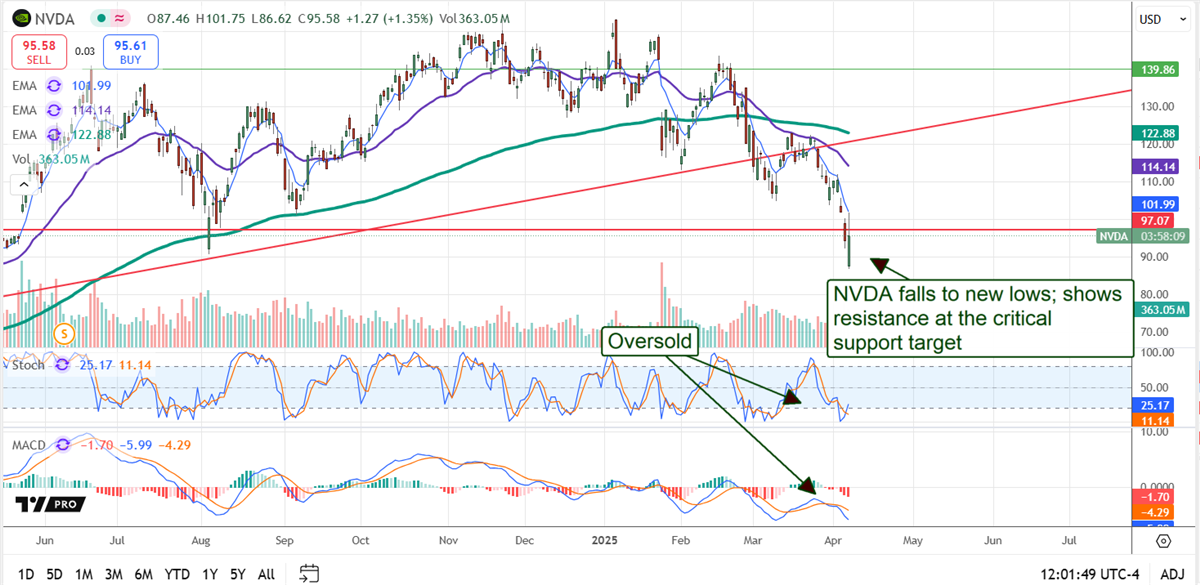NVIDIA (NASDAQ:NVDA) share price reached a 40% decline in early April and may fall further. The broad market is amid a massive, tariff-induced reset that will take months to play out and have long-lasting repercussions. The honest truth is that NVIDIA’s share price could shed 100% of its value, but that is highly unlikely given its industry, market-leading position in AI, and cash flow.
The company’s cash flow has grown in tandem with the AI boom and provides sufficient funds for reinvestment, balance sheet maintenance, capital returns, and improving value. More importantly, the company is well-positioned to continue investing in AI regardless of tariffs or economic conditions.
Highlights at the end of F2024 include a $17 billion annual increase in the cash position, up 67% year-over-year, a 70% increase in total assets, and an 80% increase in equity. The company is net cash relative to total liability and is expected to produce robust cash flow in F2025 and F2026.
The headwind for the share price in early Q2 is that analysts' sentiment trends are cooling. While still bullish overall, three reports issued in late March include two downgrades and a price target reduction. The downgrades are to Hold from Buy and to a below-consensus $125, signaling an end to the NVIDIA bull market until the next catalyst emerges, an event likely tied to easing economic uncertainty in the broad market.
When that happens, the stock price could surge by 50% to 100%. The analysts' consensus is near $170, a 75% gain from critical support levels and a new high when reached.

NVIDIA Trades at Rock-Bottom Valuation
NVIDIA’s 35% price correction has put its market at a rock-bottom valuation relative to its norms, the broad market, and the earnings forecasts. Trading at 21x the 2026 consensus in early Q2, the stock is valued at a 30% to 50% discount to recent norms and below the S&P 500 average. The stock has a deeper value relative to the long-term forecast, about 7x the 2035 consensus figure, and still a value assuming the analysts reduce their estimates.
Assuming only half the growth compared to what is currently priced in, the stock is still only 14x earnings and a value considering the cash flow and balance sheet. This sets the market up to rise by 50% to 100% over the next ten years and more if the market continues to fall.
NVIDIA’s Tariff Threat: Low-Impact and Short-Lived
NVIDIA is not entirely immune to the tariff threat but has so far dodged the bullet.
Not only has the company been working to onshore more of its production, but semiconductors are largely exempt from the tariffs. There is a risk that they could be targeted, but the impact will be short-lived for NVIDIA.
Efforts to increase domestic production include a partnership with Taiwan Semiconductor Manufacturing (NYSE:TSM), which has pledged $100 million worth of investment.
That is in addition to the hundreds of billions alluded to by NVIDIA CEO Jensen Huang, specifically for U.S. microchip production.
The money will go toward new and expanded facilities, including the most advanced packaging, ensuring NVIDIA’s AI chips can be 100% domestically produced.
NVIDIA Sell-Off Reaches Turning Point
NVIDIA’s sell-off reached a turning point in early Q2, falling to a new low below critical resistance at the $97 level. That level aligns with prior highs and a support bounce in mid-2024 and may produce significant resistance if there is no quick rebound.
In that scenario, NVIDIA’s stock could fall to $80 or lower. A move above $97 would confirm the presence of support at the bottom of NVIDIA’s trading range and likely result in an upwardly drifting but still range-bound market.
Among the potential catalysts are a reduction in global economic uncertainty and upcoming earnings releases. The company’s FQ1 release is due in May; analysts expect revenue growth to slow but to a strong 67%, with corresponding and comparable earnings growth.
